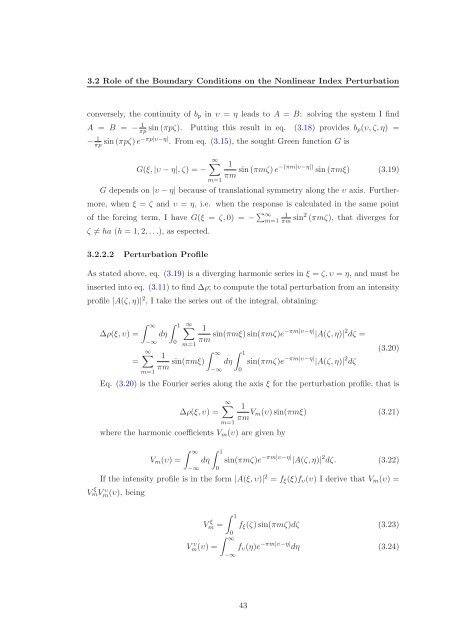Solitons in Nonlocal Media
Solitons in Nonlocal Media
Solitons in Nonlocal Media
You also want an ePaper? Increase the reach of your titles
YUMPU automatically turns print PDFs into web optimized ePapers that Google loves.
3.2 Role of the Boundary Conditions on the Nonl<strong>in</strong>ear Index Perturbation<br />
conversely, the cont<strong>in</strong>uity of bp <strong>in</strong> υ = η leads to A = B: solv<strong>in</strong>g the system I f<strong>in</strong>d<br />
A = B = − 1<br />
πp s<strong>in</strong> (πpζ). Putt<strong>in</strong>g this result <strong>in</strong> eq. (3.18) provides bp(υ, ζ, η) =<br />
− 1<br />
πp s<strong>in</strong>(πpζ) e−πp|υ−η| . From eq. (3.15), the sought Green function G is<br />
G(ξ, |υ − η|, ζ) = −<br />
∞<br />
m=1<br />
1<br />
πm s<strong>in</strong>(πmζ) e−(πm|υ−η|) s<strong>in</strong>(πmξ) (3.19)<br />
G depends on |υ − η| because of translational symmetry along the υ axis. Further-<br />
more, when ξ = ζ and υ = η, i.e. when the response is calculated <strong>in</strong> the same po<strong>in</strong>t<br />
of the forc<strong>in</strong>g term, I have G(ξ = ζ,0) = − ∞<br />
m=1 1<br />
πm s<strong>in</strong>2 (πmζ), that diverges for<br />
ζ = ha (h = 1, 2, . . .), as espected.<br />
3.2.2.2 Perturbation Profile<br />
As stated above, eq. (3.19) is a diverg<strong>in</strong>g harmonic series <strong>in</strong> ξ = ζ, υ = η, and must be<br />
<strong>in</strong>serted <strong>in</strong>to eq. (3.11) to f<strong>in</strong>d ∆ρ; to compute the total perturbation from an <strong>in</strong>tensity<br />
profile |A(ζ, η)| 2 , I take the series out of the <strong>in</strong>tegral, obta<strong>in</strong><strong>in</strong>g:<br />
∆ρ(ξ, υ) =<br />
=<br />
∞<br />
−∞<br />
∞<br />
m=1<br />
1<br />
dη<br />
0<br />
∞ 1<br />
πm s<strong>in</strong>(πmξ)s<strong>in</strong>(πmζ)e−πm|υ−η| |A(ζ, η)| 2 dζ =<br />
m=1<br />
1<br />
πm s<strong>in</strong>(πmξ)<br />
∞<br />
−∞<br />
dη<br />
1<br />
0<br />
s<strong>in</strong>(πmζ)e −πm|υ−η| |A(ζ, η)| 2 dζ<br />
(3.20)<br />
Eq. (3.20) is the Fourier series along the axis ξ for the perturbation profile, that is<br />
∆ρ(ξ, υ) =<br />
∞<br />
m=1<br />
where the harmonic coefficients Vm(υ) are given by<br />
Vm(υ) =<br />
∞<br />
−∞<br />
dη<br />
1<br />
0<br />
1<br />
πm Vm(υ)s<strong>in</strong>(πmξ) (3.21)<br />
s<strong>in</strong>(πmζ)e −πm|υ−η| |A(ζ, η)| 2 dζ. (3.22)<br />
If the <strong>in</strong>tensity profile is <strong>in</strong> the form |A(ξ, υ)| 2 = fξ(ξ)fυ(υ) I derive that Vm(υ) =<br />
V ξ mV υ m(υ), be<strong>in</strong>g<br />
V ξ 1<br />
m =<br />
0 ∞<br />
V υ m(υ) =<br />
−∞<br />
fξ(ζ)s<strong>in</strong>(πmζ)dζ (3.23)<br />
fυ(η)e −πm|υ−η| dη (3.24)<br />
43
















